Entries in event (26)
'Tis the season for good intentions
 Sunday, November 27, 2005 at 2:20PM
Sunday, November 27, 2005 at 2:20PM We all do it. There is really no point in attempting denial. Pretty much everyone is guilty as charged.
I challenge anyone to pretend that they have not, at some time or another, shirked a bit of Holiday responsibility. Nothing serious I’m sure, but maybe it was a case of promising to bring a gift for a Secret Santa (less than $25, please), and in your last minute haste you spent a whopping $27.99 at the store on the way.
Or maybe you went so far as to reach back into the closet, pull out that untouched gift Aunt Meg and Uncle Stan gave you last year, snipned off the tag and presented it as your own contribution to the festivities. Regifting never hurt anyone, has it?
Or maybe you had promised to bring a home baked treat along for the annual neighbourhood open house, and somewhere in the purchasing, packing and pandemonium of pre-holiday prep, it completely slipped your mind. So you’re faced with a dilemma - head to the party empty handed or stop over at a local bakery on the way and hope nobody notices the price tag on the box.
I was in a similar predicament this morning. I had said, weeks ago, that I would be thrilled to participate in a cookie swap. I could already imagine the smell of baking butter and sugar wafting through the house; I envisioned cookie perfection, rows upon rows of gorgeous treats all waiting to be enjoyed. I poured over recipe books and magazines, scoured baking supply stores for sanding sugar and dried egg whites.
And then I got distracted. I’m not sure by what exactly, all I know is that it was suddenly the morning of the 27th, and my cookie jar had nary a crumb. Old Mother Hubbard has my sympathies.
Not willing to give up so easily (and with the bakery not opening for another three hours), I looked to my frequent saviour - the freezer. Armed with the last sheet of puff pastry, I improvised a holiday variation on an old classic, palmiers. Flaky and crisp, and glazed with a combination of reduced jam and cinnamon sugar, these cookies belie how easy they are to make. A quick roll and 12 minutes in the oven later, you are left with a tray worthy of any cookie-swap.
Happy holidays, indeed.
Holiday palmiers
Ingredients
1/2 cup strawberry jam
1/2 teaspoon freshly squeezed lemon juice (or more, if desired)
1 inch piece of lemon zest (optional)
1 cup sugar
1/4 teaspoon salt
1/8 teaspoon cinnamon (or more, if desired)
1 sheet puff pastry, defrosted as per package instructions
Preheat oven to 450º F (230º C). Line two baking sheets with parchment paper.
In a small saucepan over medium-low heat, combine the jam, lemon juice and lemon zest (if using). Heat until the jam is melted but before it reaches a full boil. Remove from the heat and allow to cool for about 2 minutes. Using a small spoon, push the jam through a fine-meshed sieve, discarding any seeds and the lemon zest. I advise some care here, as the jam will still be rather warmå. Set aside.
In a small bowl, combine the sugar, cinnamon and salt. Spread one half of the mixture over your work surface and lay the puff pastry in the middle. Sprinkle the remaining sugar on top, and begin rolling. Turn and flip the pastry frequently, pushing the cinnamon sugar into the pastry - you want an even coating. Roll until you have a 13” by 13” square.
With a small offset spatula or butter knife and working quickly , spread the jam over the puff pastry. The jam should be in a thin layer, reaching all the way to the edges of the dough.
Fold the side of the dough halfway to the centre. Fold again, so that the two folded sides now meet in the centre. Fold one half over the other as though you are closing a book and the sides are now stacked on top of each other. Place pastry log on one of the prepared baking sheets and chill for 10 minutes in the freezer.
Remove from the freezer and slice the log into 3/4 inch slices. Place slices, cut side up back onto baking sheets and chill for an additional 5 minutes.
Bake cookies for approximately 6 minutes until the filling is bubbling and glazed and the pastry is starting to turn golden. Flip the cookies with a spatula and bake for additional 5 minutes, until caramelised and puffed. Wait a minute or so, then transfer to a baking rack to cool.
Makes about 24 cookies.
Notes:
• You can use whatever variety of jam or jelly you would like for this recipe. Reducing a clear juice (for example, cranberry) would also make a suitable filling. The jam may be omitted all together, and a coloured sanding sugar added instead for a colourful spiral design.
• The palmiers are quite delicate when they come out of the oven. For flipping and transferring to a wire rack, always use a spatula larger than the cookie to maintain its shape. A light spray of cooking oil on the spatula may also assist in transferring.
• The cut palmiers can be individually frozen on a cookie sheet, then transferred to a plastic freezer bag for storage. They should keep for approximately 2 weeks and do not need to be defrosted before baking. Cooking time may need adjustment, though.
Fall's bounty
 Thursday, September 22, 2005 at 11:26AM
Thursday, September 22, 2005 at 11:26AM I have to admit, I’ve been walking around this week feeling rather lucky. I was recently given the opportunity to have a “tasting” of some of the finest produce Niagara has to offer – namely some of the apple harvest from Schouwenaar Orchard and Vineyards.
Located just outside St. Catharines, Ontario, this family farm has been producing outstanding fruits for the last 30 years. With their diversity farming, currently boasting no less than 35 cultivars on 12 acres of land, Schouwenaar Orchards and Vineyards has an array of varietals to sample.
Their growing season starts in late June, with gorgeous cascades of glistening red and white currants, black ones following about two weeks later. Raspberries and gooseberries are next, and amazingly plump and succulent peaches soon after. Caviar bundles of blackberries end the summer with their alternating sweet and tart juice — perfect for crumbles and cakes. The clear fall sunshine falls upon the apple orchards, full and fragrant, ready for harvest. Not finished just yet, we still have the exceptional Niagara kiwiberries on the horizon.
This week has been all about the apples though. And truly, is there a fruit better suited to the coming of autumn? I will be posting some of the recipes I am experimenting with, but first I believe a bit of an introduction is in order.
Apples, regarded as a household staple and a workhorse of the kitchen, are often neglected recognition for their contribution to our tables. Not as flashy as day-glow drangonfruit or as sensually appealing as a mango, apples quietly add body, flavour and depth to so many dishes, both savoury and sweet. Almost universally enjoyed and with approximately 7,500 known cultivars, there is a flavour and texture to suit any occasion.
The selection pictured above are just a sampling of those the Schouwenaar farm has to offer:
Gala, (centre)
Crunchy and juicy with a sweet-tart taste, these small, aromatic apples blend modern and classical parentage. A cross of the Kidd’s Orange and Golden Delicious, the Gala was developed in New Zealand in the 1930s. When young, the Gala starts out very light coloured, with orange streaks over yellow. As it matures, the apple turns much darker, often a strong red. It is a reliable all-around apple, best for salads and sauces and good for pies and baking.
Elstar, (from the Gala, top left)
Developed in the Netherlands and a cross between the Ingrid Marie and Golden Delicious, this medium sized apple has firm, cream-coloured flesh. The skin has a soft sheen and is mottled yellow and red. The Elstar is a multi-purpose variety, with a sweet tart taste, best for salads and sauces and good for pies and baking.
McIntosh, (counter clockwise, below)
Sweet with a touch of acidity, the McIntosh apple is probably one of the best known. Deep crimson skin and bright white flesh typify this apple, and a taste that is simple and direct. Even though there are more than 3,000,000 McIntosh trees in North America today, they are all from an original grove discovered on the farm of John McIntosh in Dundela, Ontario sometime in the early 1800s. Macintoshes cook down quickly, and so are ideal for sauces. If using in a pie, it is necessary to add a thickener such as cornstarch to bind.
Redcort, (to the right)
A limb mutation of the Cortland apple, this is a crisp, sweet and mellow-flavoured apple. Large red, almost purple sometimes, the Redcort has tender white flesh that is slow to oxidize. This is an excellent apple for desserts.
Honeycrisp, (to the right)
A new variety of apple, developed by the University of Minnesota, it is a cross between the Honeygold and Mancoun. With an avid following of fans, the Honeycrisp lives up to its name, with crispy juicy flesh that seems to snap when bit. Juicy enough to almost be considered effervescent, the taste is sub-acid and ideal for eating raw. The apple is large, with a mottled red over a yellow background. Perfect for most preparations, eating raw, baking, cooking and sauces.
Gingergold, (above)
A cross between Golden Delicious and Albermarle Pippin, this apple was discovered among uprooted trees on a Virginia orchard in the Blue Ridge Mountains. Medium to large with a smooth, greenish gold skin and a slight blush, these apples are slow to discolour when cut and maintain their crisp white flesh. Sweet and slightly spicy, this is an excellent apple for snacking and salads, and is best enjoyed fresh.
Schouwenaar Orchards and Vineyards
Their products are sold wholesale only. For those in the Toronto area they are featured at:
Badali Fruit Market – 1587 Bayview Avenue
Rock Garden – 16930 Airport Road, Caledon East
Hilite Fine Foods – 4-415 Horner Avenue
Golden Orchards – St. Lawrence Market
Highland Farms – Locations throughout Toronto
Harvest Wagon – Yonge Street
Parkway Fine Foods - 881 Elgin Avenue East
There are great resources for apple information available online. One article of particular interest, Skin Deep discusses the correlation between colour and taste of apples.
Look out for recipes next week.
Unpacking the boxes
 Monday, July 11, 2005 at 11:32AM
Monday, July 11, 2005 at 11:32AM Welcome to the new site! Moving has resulted in a bit of technical difficulty, and I appreciate everyone hanging in there! Hopefully today or tomorrow I will be starting my five cookbook spotlight, beginning with The Best by Paul Merrett, Silvana Franco and Ben O'Donoghue.
The essence of home
 Wednesday, June 29, 2005 at 10:59AM
Wednesday, June 29, 2005 at 10:59AM I’ve been putting off writing this post. The topic seemed simple enough, but whenever I tried to come up with an answer to the question, I was overwhelmed.
“What does Canada taste like to you?”
Deciding on one taste that most embodies the Canadian experience is, in my opinion, nearly impossible. With a country of such physical size and cultural contrasts, to concentrate on one flavour would be to exclude the thousands of other culinary adventures there are to be had.
To me, Canada tastes like maple syrup on my father’s French toast. I think of a butter-drenched crab boil on one coast, and Asian-influenced seafood on the other. Summer evenings wandering the streets of Montréal, shopping for decadent Opéra cakes. The requisite hotdog from Toronto street vendors. Breakfast cooked over a campfire, with smoky bacon and biscuits baked in a cast iron pan.
Canada tastes as sweet as summer fruit, as hearty as pierogies and as complex as our world-renowned wines. Canadian food reflects our varied climates, our landscapes and our seasons – it is the expression of the way we have created communities in this immigrant nation, and suggests the direction of what is to come.
Despite my travels, I would wager to say 85% of all the meals I’ve ever eaten have been in Canada. Seeing that I’m now somewhat obsessed with food, my food adventures this country surely have been nothing short of inspiring. Though I am itching to continue to travel the world and try new things, Canada will always be home to me. There is enough to explore down the street, throughout the province and across the nation to sustain me for years to come.
Maybe it would be easier if I concentrated on what Canada Day tastes like to me?
That’s easy. Growing up in a city on the edge of Lake Ontario, Canada Day meant one thing, and one thing alone – the annual Lion’s Club carnival. Every long weekend for the summer, the Lion’s Club carnival would make its rounds through local fairs and festivals throughout our region. And Canada Day was when it would come to my city.
Along with the other kids in our neighbourhood, I would watch the workers set up the tilt-a-whirl, Ferris wheel, and midway down by the beach. Soon enough, you could smell the popcorn and the air would become heavy with the sweetness of cotton candy. Twinkling lights would greet nightfall, and we would wait for the inky blackness to blanket the lake completely – setting the stage for the evening’s fireworks display.
Inspired by those memories, I’ve created miniature sweet wonton cones filled with icewine-macerated strawberries. The strawberries come from a nearby farm, the wine from a winery down the highway, and the wontons are my nod to Canada’s distinct cultural heritage. It is seasonal, the ingredients are local, and there is a bit of kitschy humour – how very Canadian. And red and white on Canada Day - how can you go wrong?
For an explanation of icewine and its production, click here.
Icewine strawberries in sweet wonton cones
My own creation, with apologies to Thomas Keller
Ingredients
1 pint strawberries
1/4 cup icewine
1 cup clarified butter
16 x 3 1/2” square wonton wrappers (4 are in case of mishap – and anyway, that is what my package contained)
2 tablespoons granulated sugar or Demerara sugar
Sweetened whipped cream, to serve
Speciality utensils
12 conical shaped metal forms (the type used for kulfi will do) or conical paper cups for water dispensers
Preheat oven to 350°F (175°C).
Hull and slice the strawberries, taking into account the size of your cone forms. Add the berries to a bowl and add the icewine. Stir lightly to combine, and refrigerate for at least two hours.
On a baking sheet, set out the metal forms or the paper cups. Brush each wonton on both sides with clarified butter. Wrap wonton wrappers around the cups to form cones, making sure to press the seams together. Twist the bottom to secure the point, if necessary. Lightly dust the cones with the granulated sugar, and bake for 7 minutes or until golden brown and crispy. Allow to cones to cool and remove from forms.
To serve, mound some of the macerated strawberries into your sugared cones, and top with the whipped cream.
Notes
• I used an Inniskillin 2002 Riesling Icewine for this recipe, thinking the floral apricot notes and bright acidity would complement the strawberries. Any icewine you enjoy would be suitable, or even a late harvest Vidal would be a great substitution, offering a bit of spice and sweet peach flavours.
• For Ontario readers, the LCBO does offer icewine in small bottles (a bit larger than hotel room minis). This size would be perfect to splash on a few berries, and are reasonably priced.
• I chose not to add sugar to the berries, but you may want to check for sweetness and add sugar accordingly.
• For the photograph, I used a non-sugared cone. It was terribly humid that day, and sugar was melting into a sticky mess. However, I would not suggest skipping this step as the wonton seems too savoury without this bit of gilding.
• The next time I make these cones, if I'm feeling particularly industrious that is, I think I would experiment with a tuile cone instead - if anyone experiments, please let me know!


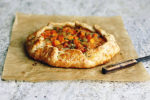
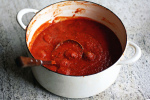
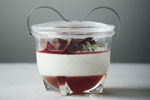
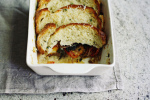
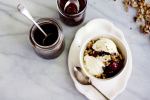

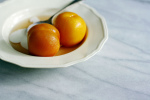










.gif)

